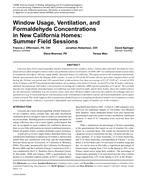This study was conducted to provide quantitative data on the dispersal of spores from fungal colonies growing on air-handling system duct materials. Three types of duct material (galvanized metal, rigid fibrous glass ductboard, and fiber-glass duct liner) were soiled in the laboratory, contaminated with a known concentration of Penicillium chrysogenum spores, and incubated in humidity chambers to provide a matrix of growing, sporulating fungal colonies consistent for all materials. For each experiment, a contaminated duct section was inserted into the air-handling system of an experimental room, and the air-handling system was operated in cycles. The airborne concentration of culturable P. chrysogenum spores, total P. chrysogenum spores, and total P. chrysogenum-sized particles were measured in the room using Andersen single-stage impactor samplers, Burkard slide impactor samplers, and an aerodynamic particle sizer, respectively. The highest airborne concentrations were measured during the first operating cycle of the air-handling system for all duct materials with decreasing airborne concentrations measured during the second and third cycles. There was no significant difference in spore dispersal from the three contaminated duct materials. These data demonstrate the potential exposure for building occupants to high concentrations of spores dispersed from fungal colonies on air-handling system duct materials during normal operation of the system.
Authors: Mark P. Buttner, Ph.D., Linda D. Stetzenbach, Ph.D.
Citation: Indoor Air Quality 2001 Moisture, Microbes, and Heath Effects: Indoor Air Quality and Moisture in Buildings Conference Papers
Keywords: November, California, 2001, IAQ
Citation: IAQ Conference: IAQ 2001
Product Details
- Published:
- 2001
- File Size:
- 1 file , 100 KB
- Product Code(s):
- D-8176


